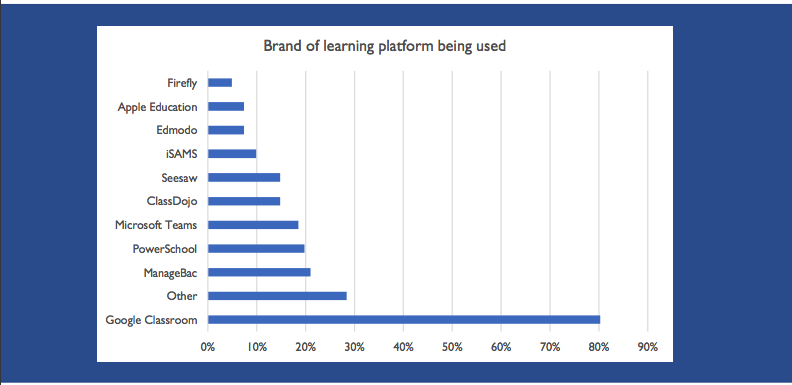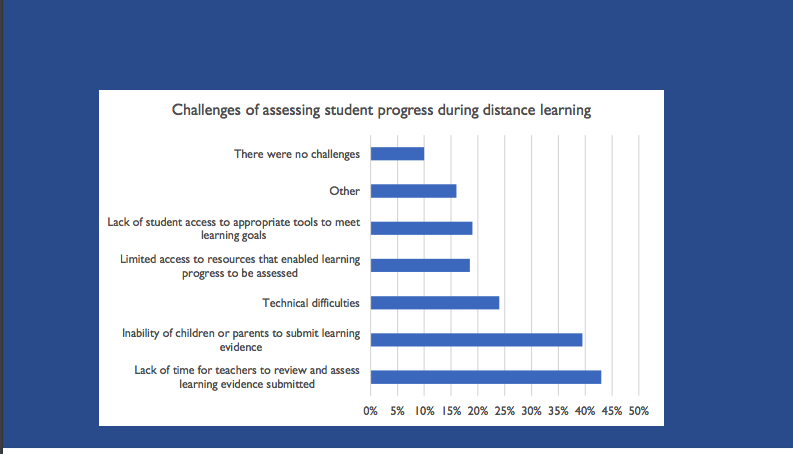The Ed-Tech Tools International Private Schools Have Turned to During COVID-19
When COVID-19 shut down school buildings across the world, most international private schools — a booming sector for U.S. ed-tech vendors — turned to a free tool, Google Classroom, to power remote learning efforts, a global report concludes.
That’s one of the key takeaways from a new ISC Research report surveying school leaders and technology directors at 82 international schools in 41 countries on ed-tech usage. It looks specifically at how effective and accessible different learning platforms were when educators were thrust into emergency distance learning due to the pandemic.
The report, based on a survey of international private schools this summer, also examined the tools used most frequently by teachers, and tech challenges schools faced to deliver effective remote learning.
The United Kingdom-based ISC provides data and intelligence on international private schools, a rapidly-growing market that now encompasses about 5.8 million students in 11,500 schools around the world offering instruction primarily in English and with an international orientation.
As is the case in U.S.-based schools, administrators, teachers and students at the private schools overseas also experienced some of the same mishaps that stymied distance learning, ISC found. Those include broadband connectivity woes, a lack of access to devices for students, and teachers inadequately trained with ed-tech tools. About 42 percent of schools said they experienced “significant challenges” with tech used to deliver distance learning.
But most international private schools were well prepared and able to leverage technology effectively to adapt to the crisis quickly, the report found.

According to the report, just about every school surveyed — 99 percent — responded that it had an online learning platform to lean on during COVID-19 distance learning.
And a whopping 80 percent of schools said they turned to Google Classroom to help facilitate those online lessons, which was more than twice as many responding to the second most used platform: “other.”
Overall, the report concludes that international schools not only recognized technology as an essential part of distance learning but are using Covid-19 as a “catalyst” to change how curriculum is delivered post-pandemic.
Most Used Learning Platform
Google Classroom said in early April, as the coronavirus outbreak caused school buildings around the world to close their doors, that it had more than doubled its active users on the platform to more than 100 million. So it’s not surprising that Google Classroom was also the top choice for learning platforms among international private schools in the survey.
After Google, about 20 percent of schools surveyed said they used ManageBac and PowerSchool, with Microsoft Teams, Class Dojo and Seesaw ranking as the next most popular choices. The report notes that several schools use a combination of platforms.
What Tool Did Teachers Consider Most Valuable?
Nine out of 10 surveyed school officials said teachers considered synchronous communication platforms — such as Zoom, Google Meet and Sype — the most indispensable during distance learning. (A recent EdWeek Market Brief survey of U.S. district officials also found that Zoom, as well as Google, were seen as especially helpful to their work during COVID-19.)
For most schools, having a mix of solutions was considered essential for delivering learning to students during campus closures.
One school leader from the International School Manila in the Philippines commented in the report: “For our ES [elementary school] students and teachers, the combination of Zoom, Seesaw, Google Slides and Clever SSO has been core to delivering teaching and learning. For MS [middle school] and HS [high school], Zoom, Google Classroom and Clever SSO were our core systems.”

Ed Tech as the ‘Catalyst’ For Curriculum Change
Moving forward, 84 percent of international private schools say they plan to integrate ed-tech tools much more into daily curriculum as a result of their experiences during COVID-19 remote learning.
In fact, some international schools, according to the report, regard their experience with technology during campus closures as a “catalyst to significant change for their future school development.”
The director of curriculum and innovation and technology at the International School of Düsseldorf in Germany commented in the report that: “We’ve learned many lessons and plan to keep tools and some practices that made learning and communication better.”

Distance Learning Assessment Challenges
A majority of international private schools — some 63 percent — said they had a solution in place to track student progress through assessment. Several schools, according to the report, “created a solution” through Google Classroom, while others relied on several different tools, including the most basic: teacher feedback.
But school leaders believed their success in tracking student progress was “limited,” citing a number of challenges. Only 10 percent of surveyed schools said they experienced no challenges with assessments.
The most common challenge for schools “was teachers having insufficient time to support students with their distance learning and also review and assess the learning evidence that was submitted.” More than 40 percent of respondents cited this as their biggest hurdle to effective assessments.
See also:
